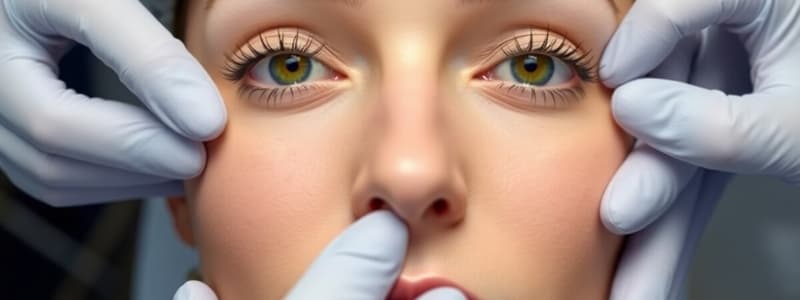Podcast
Questions and Answers
What is the primary focus when assessing the infra-orbital volume deficit?
What is the primary focus when assessing the infra-orbital volume deficit?
- The amount of native fat available for preservation (correct)
- The potential for postoperative edema
- The patient’s expectations and perceptions
- The type of surgical procedure to be performed
Which of the following is NOT mentioned as a method for managing native fat?
Which of the following is NOT mentioned as a method for managing native fat?
- Excised
- A combination of excision and repositioning
- Repositioned
- Replaced with synthetic materials (correct)
What is a potential complication that may arise postoperatively?
What is a potential complication that may arise postoperatively?
- Increased eyelid fat deposits
- Prolonged postoperative edema (correct)
- Enhanced skin elasticity
- Complete loss of native fat
Which technique is mentioned as a non-invasive option for periorbital rejuvenation?
Which technique is mentioned as a non-invasive option for periorbital rejuvenation?
What anatomical features are deemed essential for successful treatment planning?
What anatomical features are deemed essential for successful treatment planning?
What technique is suggested to help resolve the 'troublesome triad'?
What technique is suggested to help resolve the 'troublesome triad'?
What is emphasized as vital during the preoperative assessment?
What is emphasized as vital during the preoperative assessment?
Which statement reflects a potential future advancement in treatment technology?
Which statement reflects a potential future advancement in treatment technology?
What is a primary benefit of fractional laser resurfacing for eyelid skin?
What is a primary benefit of fractional laser resurfacing for eyelid skin?
What can potentially occur as a complication of fractional laser treatments?
What can potentially occur as a complication of fractional laser treatments?
What causes palpebral bags to form in the lower eyelid area?
What causes palpebral bags to form in the lower eyelid area?
What is a critical factor to consider when planning surgery for eyelid correction?
What is a critical factor to consider when planning surgery for eyelid correction?
What is a concern when over-resecting infra-orbital fat?
What is a concern when over-resecting infra-orbital fat?
How does age-related maxillary hypoplasia affect tear troughs?
How does age-related maxillary hypoplasia affect tear troughs?
What must be avoided to ensure proper lid positioning post-surgery?
What must be avoided to ensure proper lid positioning post-surgery?
Which condition can complicate treatment decisions for palpebral bags?
Which condition can complicate treatment decisions for palpebral bags?
Flashcards
Infra-orbital volume deficit
Infra-orbital volume deficit
A deficiency in the volume of tissue below the eye socket.
Native fat preservation
Native fat preservation
Keeping the existing fat in the face during surgery.
Fat repositioning
Fat repositioning
Moving fat from one place in the face to another.
Intra-SOOF procedure
Intra-SOOF procedure
Signup and view all the flashcards
Lower eyelid fat repositioning
Lower eyelid fat repositioning
Signup and view all the flashcards
Periorbital rejuvenation
Periorbital rejuvenation
Signup and view all the flashcards
Non-invasive techniques
Non-invasive techniques
Signup and view all the flashcards
Malar mounds
Malar mounds
Signup and view all the flashcards
Fractional laser resurfacing
Fractional laser resurfacing
Signup and view all the flashcards
Malar bags
Malar bags
Signup and view all the flashcards
Orbital septum and oculi muscle
Orbital septum and oculi muscle
Signup and view all the flashcards
Eyelid vector
Eyelid vector
Signup and view all the flashcards
Tear trough deformity
Tear trough deformity
Signup and view all the flashcards
Negative eyelid vector
Negative eyelid vector
Signup and view all the flashcards
Palpebral bags
Palpebral bags
Signup and view all the flashcards
Treatment for palpebral bags
Treatment for palpebral bags
Signup and view all the flashcards
Study Notes
Periorbital Rejuvenation Techniques
- Fractional laser resurfacing improves malar bags and eyelid skin, but doesn't reposition structures. May stimulate collagen, tighten tissue, or correct skin folds. Potential risks include scarring, ectropion, and hyperpigmentation.
Palpebral Bags
- Develop at any age, caused by infra-orbital fat bulging against a weakened orbital septum and oculi muscle.
- Reinforcement of these structures is crucial for correction.
- Lid vector (relationship between cornea and lower lid/cheek) should be considered.
- "Negative vector" occurs when the cornea is more anterior than the lower lid, requiring extra care to avoid lid over-tightening or skin excision issues.
- Tear trough deformity often relates to maxillary hypoplasia and loss of subcutaneous fat.
- Debate over whether tear trough deformities should be considered during palpebral bag treatment.
- Infra-orbital fat volume deficit and available native fat should balance during treatment.
- Fat may be excised, repositioned, or a combination.
- Procedures like "intra-SOOF" secure fat pads.
- Some centers prefer fat repositioning alone, others add lower eyelid tightening or implants.
- Postoperative edema and recurrence are possible.
Non-Invasive Treatments
- Laser resurfacing and Ultherapy can be adjunctive in selected cases.
- Future advancements like non-invasive polymer emulsion may be useful.
Treatment Approach
- Awareness of festoons, malar mounds, and palpebral bags is essential.
- Preoperative assessment and patient discussion are vital.
- Patient perceptions and expectations are crucial for acceptable results.
- Combining malar septum repositioning, midface lifting, and liposculpting targets individual abnormalities and restores the "troublesome triad".
- Ongoing advancements expand rejuvenation options.
Studying That Suits You
Use AI to generate personalized quizzes and flashcards to suit your learning preferences.

